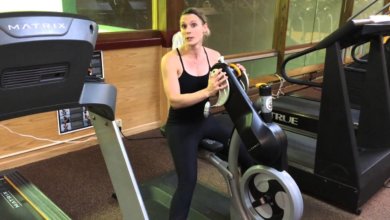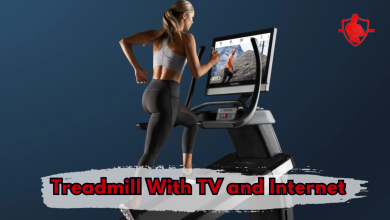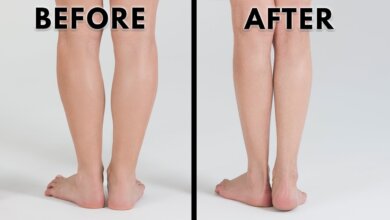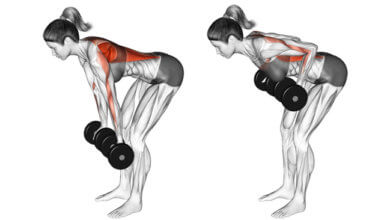Ring Rows Alternative Exercises

Ring Rows are finally getting the attention and love they much deserve. Also called Inverted Rows, these are a phenomenal exercise with a laundry list of benefits.
From helping you nail your first unassisted pull-up, to reducing dysfunctional movements caused by prolonged poor posture, Ring Rows should be included in every workout program around the world.
There's a slight problem though. Not many gyms or homes have rings. What if you are travelling and need to shower some ring row love on your back? Do you skip it altogether?
I faced a similar conundrum multiple times thanks to my nomadic lifestyle, and that's what led me to research about Ring Row alternative exercises. Much to my chagrin, I found it tough to find exercises that provide the exact stimulus that ring rows do, with as much effort.
Most exercises that were touted to be mirror replicas, either drastically reduced the muscle stimuli, or was not exactly beginner-friendly, as ring rows are. It took me all of 8-months to create a list of travel-friendly ring-row alternatives, which I am going to share with you today.
What is the Ring Row Exercise?
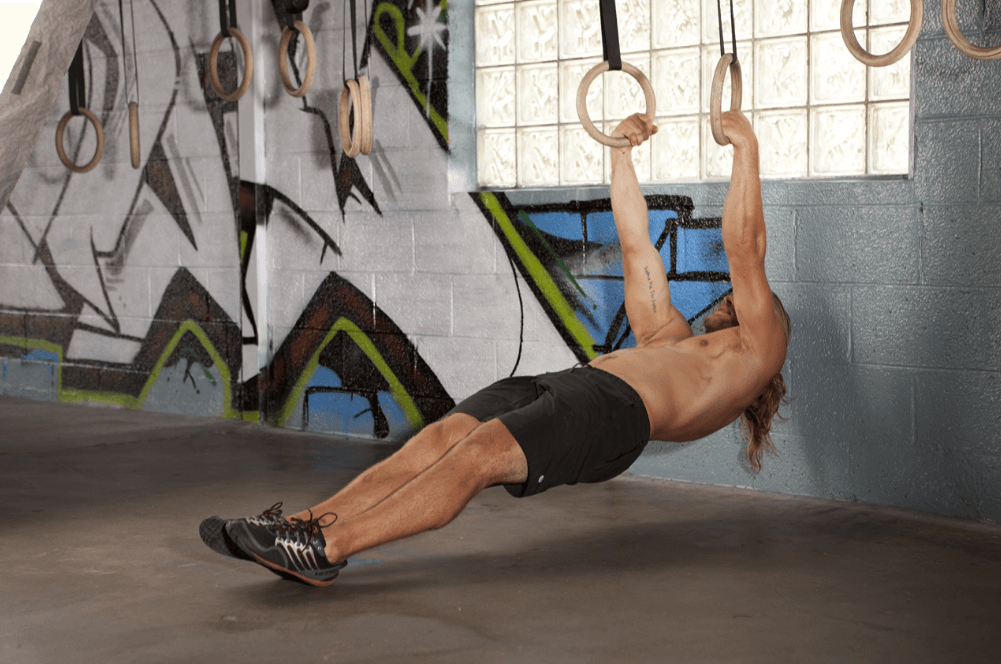
The Ring Row or the inverted row is a horizontal rowing move performed on a pair of rings, with you pulling your body upwards towards the ring, with your feet planted on the ground, or hanging off it.
It's known by multiple other names like the Horizontal row, or the Reverse Pushup to name a few. What makes it so effective is that it has a low learning curve, recruits more muscle fibers than what you can see in the mirror, and has excellent carry-on value with potential benefits in sports performance as well as mainstream bodybuilding.
Benefits of the Ring Row
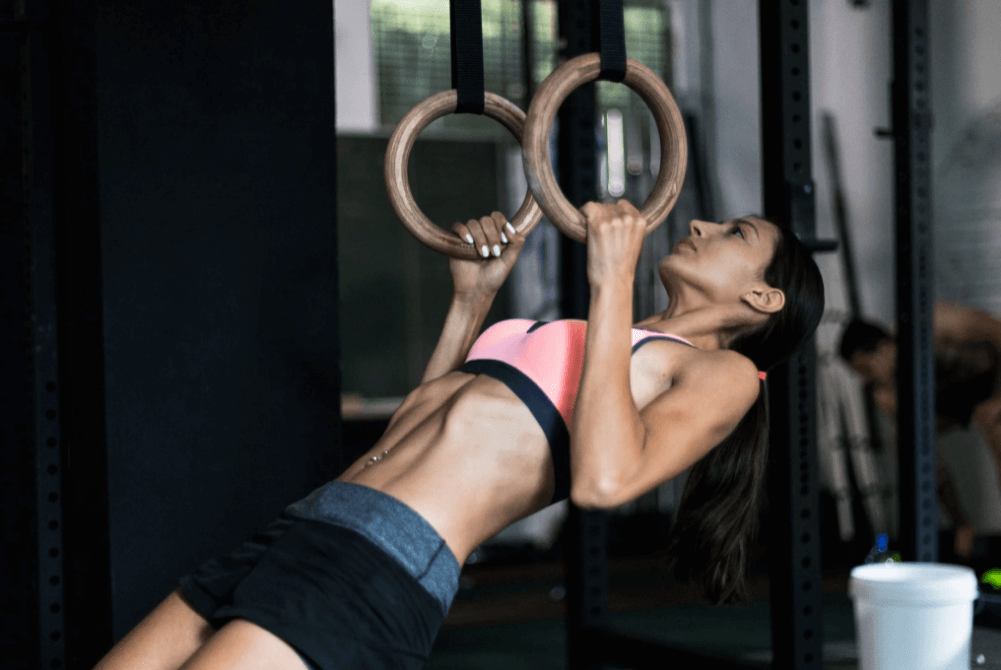
Let's take a magnified view at that benefit list, shall we?
The Building Block of the unassisted pull up
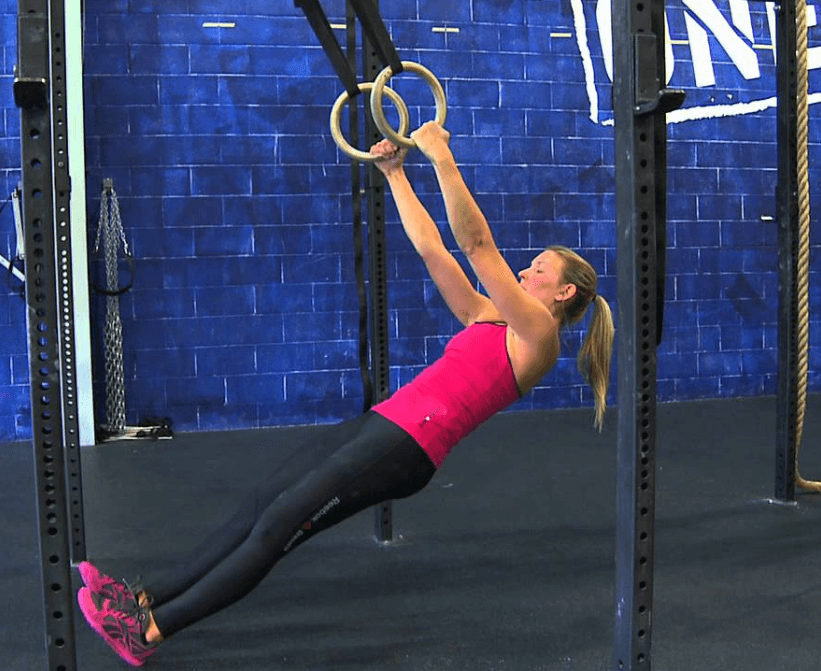
Pull Ups are a fitness goal for a lot of individuals. A lot of them give up on them too soon, but it's not their fault. Pull Ups are an advanced lifting move that require significant strength to perform with good form. We are not talking about Kip-Ups where you flay your arms and swing like an ape.
We are talking about strict, controlled pull-ups. While they can be learned with practice, removing the requirement for strength makes Ring Rows a great alternative to pull ups for beginners and intermediates alike.
You can start off with ring rows with your feet firmly planted on the ground and eventually progress to Ring Rows with your feet suspended in mid-air. And if you are good to go, nothing stops you from transitioning to the actual pull-up.
Improving Midline Stabilization
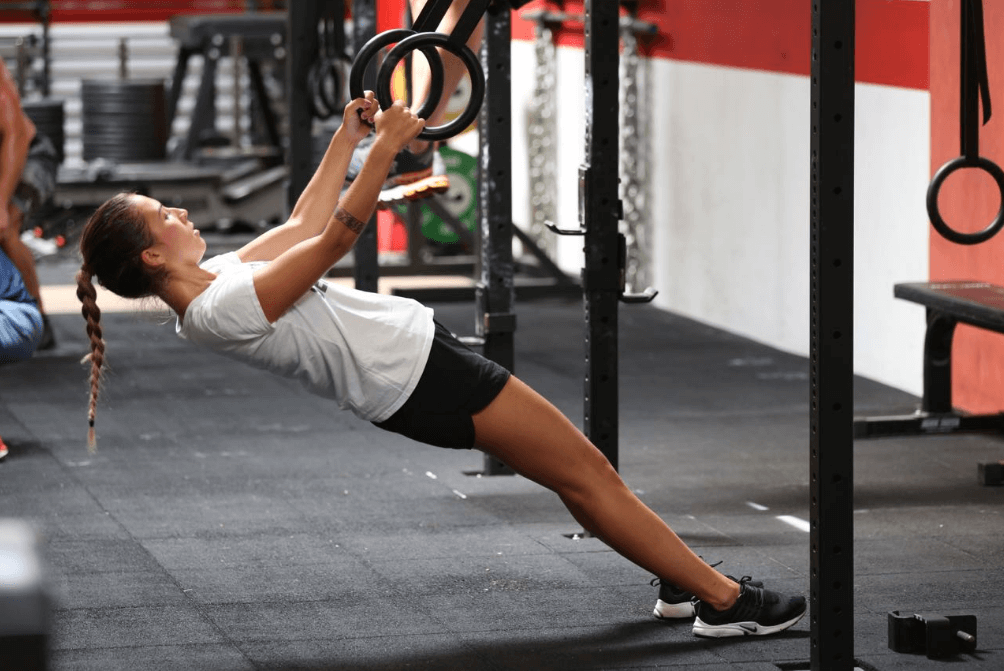
Midline Stabilization is crucial for almost every single free-weight exercise. It is the ability to maintain a neutral spine position under load, through the complete range of motion. Be it a squat, or a row, you need midline stabilization to remain injury free.
It will also lead to development of more functional strength - which helps you lift more weight on bigger lifts like squats and deadlifts - as well as reduces the risk of injuries from prolonged bad posture brought about by sedentary lifestyles.
Strength Development
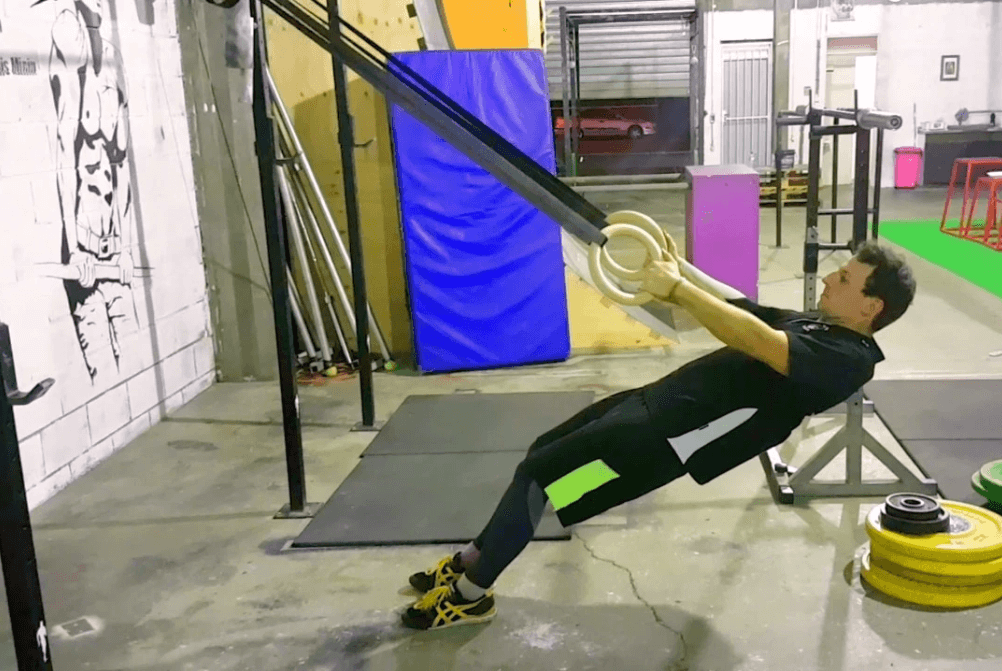
Ring Rows engage every single muscle in your upper body and core. It lays a great foundation for strength development as you progress from the beginner phase to more complex lifts.
It helps strengthen your shoulders, biceps, triceps, back muscles, abs and even abs. Even if you are not using it as a stepping stone for pull-ups, Ring Rows offer tremendous value as a standalone exercise.
How to do the Ring Row Exercise

Here is a video of how to do ring rows.
Here are step by step instructions to do the ring row.
- Step 1 - Get under a pair of rings in the gym.
- Step 2 - Assume a reverse plank position with the rings set up directly in front of your head.
- Step 3 - Grab the rings with the palms facing each other (neutral grip), and initiate the movement by pulling your chest towards the rings, while maintaining a neutral spine. Exhale when you are at near maximal contraction, and inhale as you go back to the starting position.
- Step 4 - If you are starting off with ring rows, your feet should be planted on the ground. In time, you may progress to performing ring rows with your feet suspended in mid-air.
Top 3 Best Alternatives for Ring Row Exercise

As I mentioned, rings are not a universal fitness equipment. They are hard to come by, even in modern gyms. It's tough to go ahead and buy them if you are not sure, especially when you are starting out.
So, I have compiled 3 of the most effective alternatives for Ring Rows exercises that you can use instead.
#1 - The Inverted Barbell Row - My Personal Favorite

The Inverted Barbell Row is the most logical substitute for Ring Rows. It is an extremely effective pulling exercise that targets the lats and the upper back, and it also brings in the stability aspect to an extent, which helps improve overall strength and size of your midline muscles. This exercise is similar to the Australian pull up exercise.
It does not require special equipment either, like rings. Even a simple barbell squat rack will get the job done.
Here is a video of how to do this exercise:
Muscles worked by the inverted barbell row
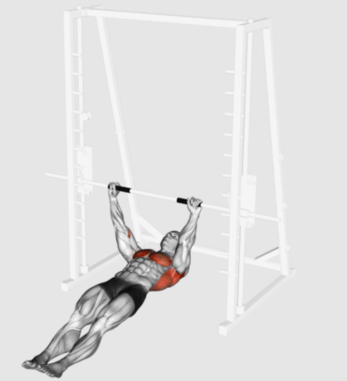
The Inverted Barbell Row is a compound move that recruits multiple muscle groups of the upper body, the core and your lower body.
Latissimus Dorsi
The Latismus Dorsi is the largest muscle in your back. It attaches to the arms at one end, and to the shoulder blades on the other. The lats are significant, both from an aesthetic perspective as well as from a functional point of view.
The lats allow you to do a host of movements, including pulling your chin above the bar while doing pull ups.
You can do low rows and T-bar rows also if you want to target the latissimus dorsi.
Teres Minor
The Teres Minor is a rotator cuff muscle that is located at the back of your shoulder.
It assists in abduction and extension of the shoulder. In layman's terms, it helps you move your arms away from the body and also works to bring them back.
The Teres Minor is engaged when you do Ring Rows, inverted barbell rows or any other rowing exercise.
Hamstrings
Most people are surprised when we mention the hamstrings as a major muscle group that is worked on by the inverted barbell row.
However, your hamstring muscles (which connect to your knee and work to bend it) are engaged throughout, as you recruit your stabilizer and core muscles to maintain the integrity of your spine.
How to perform the inverted Barbell Row
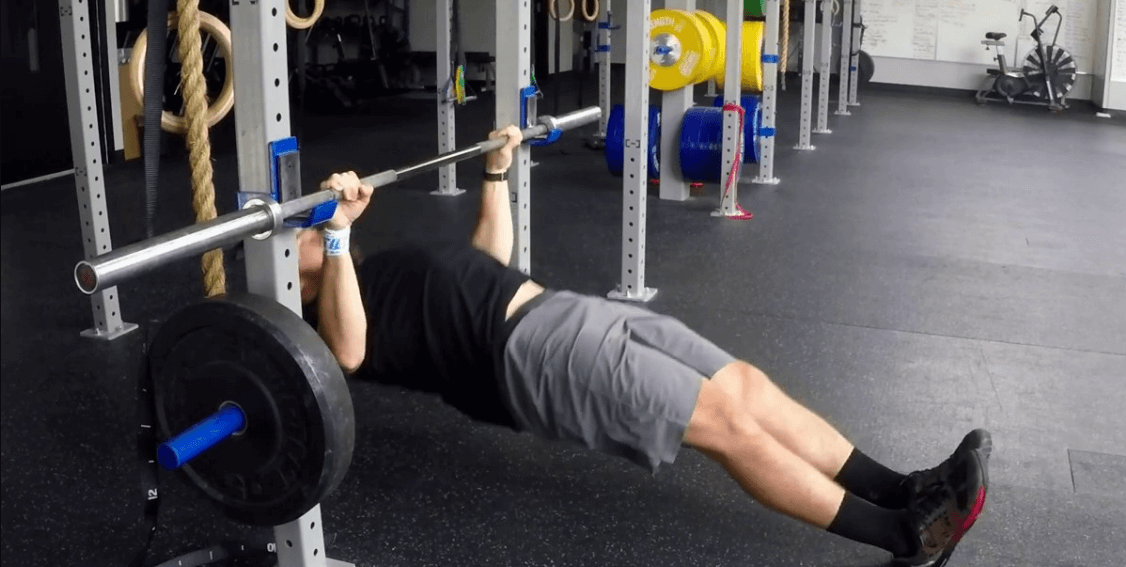
- Step 1 - Rack the barbell on a rack, or on a smith machine with adequate weight.
- Step 2 - Get under the bar in a reverse plank position and grab the bar with your hands about shoulder width apart, with an overhand grip.
- Step 3 - Again, you can choose between feet on the ground or suspended in mid-air.
- Step 4 - Initiate the movement by pulling your chest towards the bar, while maintaining a neutral spine. Pause for a second when your chest touches the bar.
- Step 5 - Slowly go back to the starting position in a controlled fashion, breathing throughout the move.
Pro Tip
Always maintain a neutral spine. For most people, it is enough to allow their legs to be planted on the ground.
Suggested Reps
6-12 reps for 3 sets should be a good starting point for most people. If you are an advanced athlete, you can do 20 or even 30 reps for one set.
#2 - Bent Over Barbell Rows
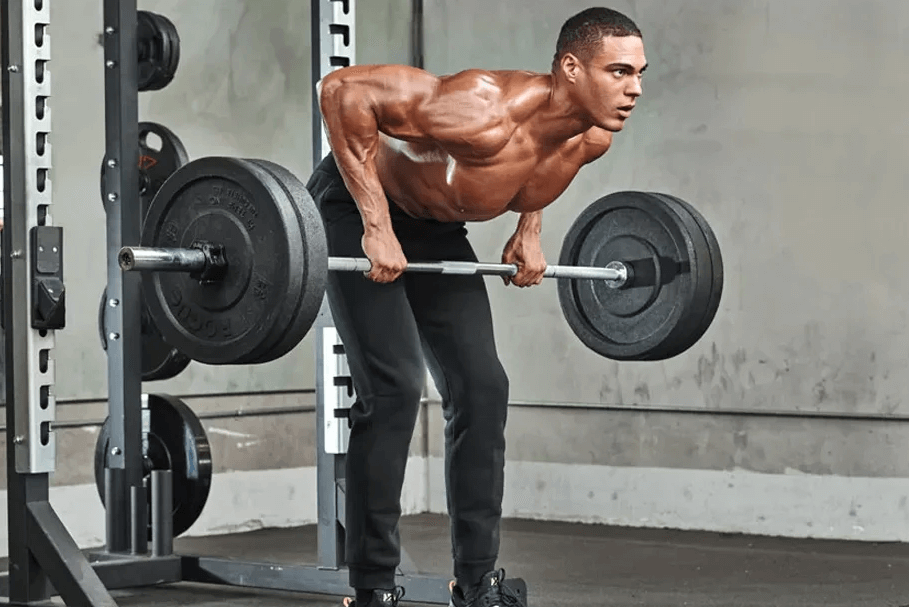
Bent Over Barbell Rows are a classic, tried and tested move that mimics the upper body position of a Ring Rows exercise. Only, instead of pulling your body weight towards the ring, you will be pulling the weight towards your body.
It does take away some of the stability requirement of the ring row, given than the bar stays stationary, while each ring moves independently. But given that we are trying to compensate for the absence of rings, doing bent over barbell rows are a good way to begin training your upper body again.
Here is a video of how to do this exercise
Muscles worked by the Bent Over Barbell Row
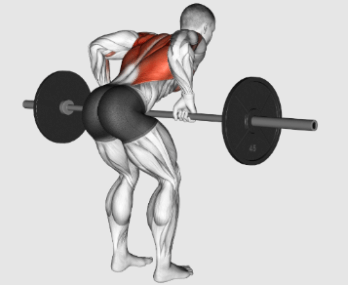
The Bent Over Barbell Row is a classic compound exercise that targets a host of upper body, core and lower body muscles.
Just like the ring row, the latismus dorsi is the prime benefactor of the bent over barbell row. But it also involves the spinal erector muscles, the glutes and hamstrings.
Spinal Erectors
Your spinal erector muscles work as stabilizers. They connect the lumbar spine to the pelvis and help you maintain a neutral spine throughout the movement.
Hamstrings
The hamstrings are engaged during the bent over barbell row as you hinge at the waist slightly, and use it as a stabilizer to maintain good posture. As a result, you will often find that athletes who have poor hamstring flexibility struggle to get the full range of motion with the barbell row.
If you want a beginner friendly exercise to work your hamstrings, you can do jump ropes or jumping jacks.
Rhomboids
Your rhomboids are engaged when you pull your shoulder blades towards each other during the pull. You can make sure to engage them by retracting your shoulder blades throughout the move.
How to perform the bent over barbell row

- Step 1 - Place the barbell on the floor. You can also use a rack here, if that's easier for you.
- Step 2 - Stand over the barbell with feet spaced shoulder width apart. Bend at the waist and pick up the barbell with your arms straight.
- Step 3 - Slowly move your torso back, while hinging at the waist. Retract your shoulder blades as you do this. Your body should now be at about a 45-degree angle to the floor.
- Step 4 - Initiate the movement by driving your elbows back, behind you. Pause when they are in line with your torso and pull your shoulder blades back and together, as you squeeze your lat muscles.
- Step 5 – Slowly come back to the starting position by lowering the bar, until they are at your ankle level.
Pro Tip
Always retract your shoulder blades back and together as you row. This will help activate the lat muscles, and keep you in good form throughout the move.
Suggested Reps
It’s tough to give you a ballpark number here because there are a variety of factors that can influence the number of reps. Generally speaking, if your goal is muscle hypertrophy, you can go from 6-20 reps depending on the weight you are lifting. For strength, focus on a low rep range at about 70% of your 1 RM and increase the intensity.
#3 - Reverse Fly

It was a toss-up between the Upright Row and the reverse fly. I chose the latter because upright rows are not exactly beginner friendly. Moreover, they can cause wrist and shoulder issues if you don't know what you are doing.
Besides, you can do these anywhere with a pair of dumbbells or even resistance bands. It's as travel-friendly as they come.
Here is a video of how to do this exercise
Muscles worked with the reverse dumbbell fly
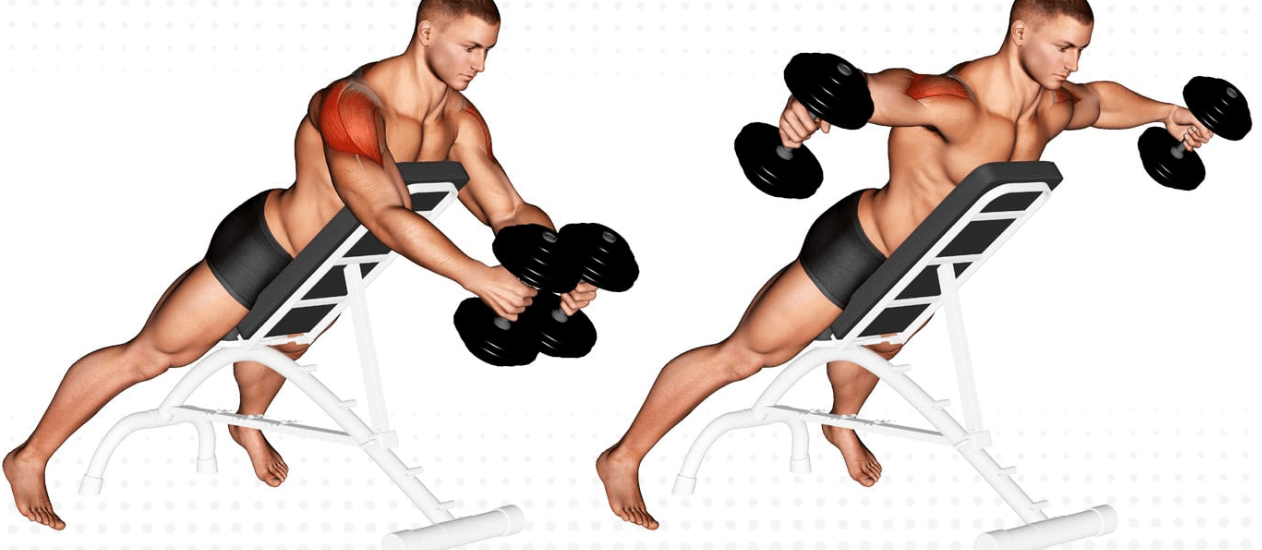
The reverse fly( A.K.A rear delt flys) is a great way to work the middle and lower trapezius muscles. It also engages the rear deltoid which you can't target with a bent over barbell row.
Posterior Deltoids
Your posterior deltoids need constant training because they are a small muscle group. The reverse fly is a great way to engage them. It's almost as effective as an isolation move for the posterior delts.
Improving your posterior deltoids can help eliminate some of the problems caused by excessive slouching in front of a computer.
Middle Traps
The middle trapezius are the meat of the exercise, so to speak. They are worked through isometric contractions when you pull your shoulder blades towards each other and squeeze them tight.
Lateral Head of the Triceps
Your posterior deltoids also play a small role in the reverse fly. It's not enough to stimulate muscle growth, but it's plenty to add onto your triceps routine without much effort.
How To Perform The Reverse Fly
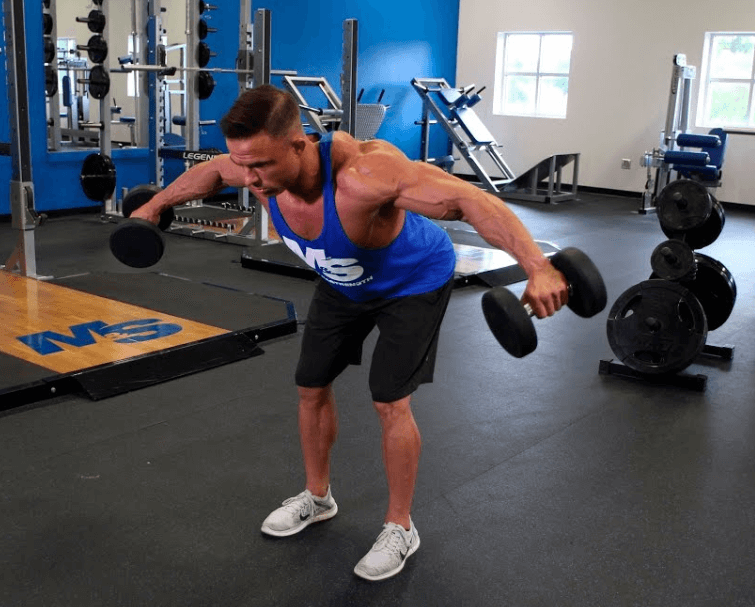
- Step 1 - Grab a pair of dumbbells and stand holding them by your sides with your palms facing each other.
- Step 2 - Hinge at the waist and let your arms hang straight down with a slight bend in the elbow.
- Step 3 - Without moving your torso, slowly move the weights up, as you lift your arms and extend them straight out to the sides.
- Step 4 - Continue moving them up until your arms form a 90-degree angle, with your upper arms at your side and the dumbbells reaching past the shoulders.
- Step 5 - Hold for a count and then slowly lower the weights back down to the starting position.
Pro Tip
Try not to use momentum when doing this move because it leaves you vulnerable to injury. The weights should always move in a controlled manner, with your upper body remaining stable throughout the workout.
Suggested Reps
This is another good move for muscle hypertrophy. Keeping the weight light and reps around 10-15 with a squeeze at the top is a good way to go.
FAQs about alternatives to Ring Row Exercise

Still have more questions on alternatives to ring row exercise? Here are more answers to commonly asked questions to help you understand all this even better.
Q. What exercise can replace Ring Row Exercise?
A. Any exercise that stimulates the same muscle groups can serve as a replacement. That means you can do it with inverted rows or bent over barbell rows, or reverse fly. This is not a definitive list. So feel free to experiment with variations.
Q. What can I do instead of ring rows?
A. That depends on your experience, postural stability and goals. You can do inverted rows or bent over barbell rows, or reverse fly instead of Ring Rows.
Q. What is the easiest substitute for Ring Row Exercise?
A. The Inverted Row is the easiest substitute. You are performing the same move, but with a stable bar instead of the rings, which constantly move around and hence, require more core stability. The inverted row practically has zero learning curve.
Q. Why are ring rows so hard?
A. It's not just ring rows. Any exercise that involves gymnastic rings are tough, even for seasoned athletes. Rings are unstable and will constantly move as you start to lift your body up. This requires your body to recruit more muscles to stay stable.
From your core muscles to tiny stabilizers in your shoulders and wrists, all of them need to work together to keep you stable during a ring row.
Q. How can you make the ring row easier?
A. It becomes a lot easier when you perform them with your feet on the floor and your body almost in a vertical position. The more perpendicular your body angle, the tougher it gets.
Q. Are Ring rows variations and modifications effective?
A. I have carefully selected variations that recruit the same muscles as the ring row does. That said, it’s impossible to mimic the unpredictability of gymnastic rings. Barring that, any one of these three variations offer excellent bang for your buck, if you do not have access to rings.
Related Readings:
- Do Pull Ups Work Abs?
- Neutral Grip Pull Ups – Everything You Need to Know
- Setting Up A Basement Gym Low Ceiling
- I Ended up Doing 1000 Pushups a Day
- Best Home Gym Setups – How To Build The Perfect Budget Setup
Resources:
- https://barbend.com/inverted-row-guide/
- https://www.coachmag.co.uk/exercises/back-exercises/177/bent-over-row
- https://www.verywellfit.com/how-to-perform-the-reverse-fly-4684392
Ben Mayz
Hi there! I'm Ben, main author and chief editor at Fitlifefanatics.com. I have been obsessed with Strength Training and Fitness for 18 years now.
My passion for living a happy fit lifestyle is what made me realize that fitness is what I wanted for my future.
I went on to earn my Masters in Sports Training & Biomechanics.
My passion for Strength training & fitness and my love of helping others is what made me start Fitlifefanatics.
Here, myself, and a team of specialist aim to provide the most accurate, and actionable information possible in hopes to help foster the fitness community forward.
You can learn more about Fitlifefanatics on our About Page


